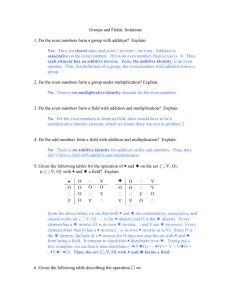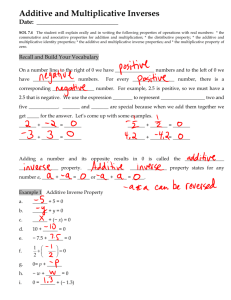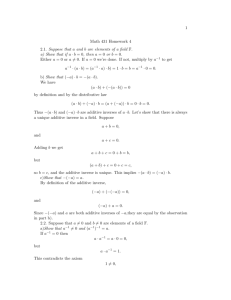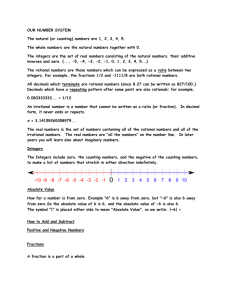Properties of the real numbers
advertisement
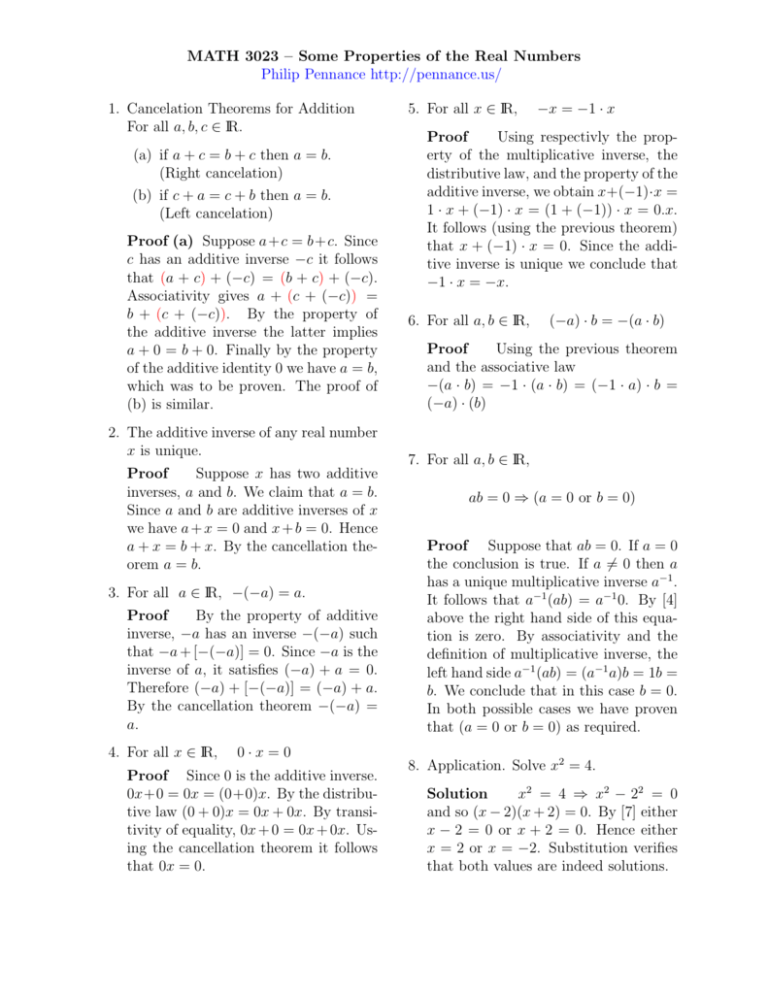
MATH 3023 – Some Properties of the Real Numbers Philip Pennance http://pennance.us/ 1. Cancelation Theorems for Addition For all a, b, c ∈ IR. (a) if a + c = b + c then a = b. (Right cancelation) (b) if c + a = c + b then a = b. (Left cancelation) Proof (a) Suppose a+c = b+c. Since c has an additive inverse −c it follows that (a + c) + (−c) = (b + c) + (−c). Associativity gives a + (c + (−c)) = b + (c + (−c)). By the property of the additive inverse the latter implies a + 0 = b + 0. Finally by the property of the additive identity 0 we have a = b, which was to be proven. The proof of (b) is similar. 2. The additive inverse of any real number x is unique. Proof Suppose x has two additive inverses, a and b. We claim that a = b. Since a and b are additive inverses of x we have a + x = 0 and x + b = 0. Hence a + x = b + x. By the cancellation theorem a = b. 3. For all a ∈ IR, −(−a) = a. Proof By the property of additive inverse, −a has an inverse −(−a) such that −a + [−(−a)] = 0. Since −a is the inverse of a, it satisfies (−a) + a = 0. Therefore (−a) + [−(−a)] = (−a) + a. By the cancellation theorem −(−a) = a. 4. For all x ∈ IR, 0·x=0 Proof Since 0 is the additive inverse. 0x+0 = 0x = (0+0)x. By the distributive law (0 + 0)x = 0x + 0x. By transitivity of equality, 0x + 0 = 0x + 0x. Using the cancellation theorem it follows that 0x = 0. 5. For all x ∈ IR, −x = −1 · x Proof Using respectivly the property of the multiplicative inverse, the distributive law, and the property of the additive inverse, we obtain x+(−1)·x = 1 · x + (−1) · x = (1 + (−1)) · x = 0.x. It follows (using the previous theorem) that x + (−1) · x = 0. Since the additive inverse is unique we conclude that −1 · x = −x. 6. For all a, b ∈ IR, (−a) · b = −(a · b) Proof Using the previous theorem and the associative law −(a · b) = −1 · (a · b) = (−1 · a) · b = (−a) · (b) 7. For all a, b ∈ IR, ab = 0 ⇒ (a = 0 or b = 0) Proof Suppose that ab = 0. If a = 0 the conclusion is true. If a 6= 0 then a has a unique multiplicative inverse a−1 . It follows that a−1 (ab) = a−1 0. By [4] above the right hand side of this equation is zero. By associativity and the definition of multiplicative inverse, the left hand side a−1 (ab) = (a−1 a)b = 1b = b. We conclude that in this case b = 0. In both possible cases we have proven that (a = 0 or b = 0) as required. 8. Application. Solve x2 = 4. Solution x2 = 4 ⇒ x2 − 22 = 0 and so (x − 2)(x + 2) = 0. By [7] either x − 2 = 0 or x + 2 = 0. Hence either x = 2 or x = −2. Substitution verifies that both values are indeed solutions. Exercises 1. Use the properties of the real numbers solve the following equations over IR. (a) 2x + 3 = 7. (b) ax + b = c (c) x2 − 2x − 63 = 0 (d) x2 − 5 = 0. (You may assume that 5 has a principal square root.) 2. Find the error in the following argument: Let a = 1 and b = 1 Then a = b and a2 = ab. It follows that a2 −b2 = ab−b2 from which (a + b)(a − b) = b(a − b) After canceling the common factor a − b we find a + b = b Putting a = b = 1 gives 2 = 1 3. Show that the following are true for all real numbers a, b, c, d. (a) If c 6= 0 and ac = bc, then a = b. (Cancellation property for multiplication) (b) a − b = −(b − a) (c) (a−1 ) −1 = a, a 6= 0 (d) −(ab) = (−a)b = a(−b) a a −a =− = , b 6= 0. (e) b b −b (f) (ab)−1 = b−1 a−1 , a, b 6= 0 a ab = c (g) c b a c ac (h) · = , b, d 6= 0 b d bd a c ad + bc (i) + = , b, d 6= 0 b d bd a ad (j) cb = , b, c, d 6= 0 bc d 4. Show that the following statements are false: x2 − 1 = x − 1 for all x ∈ IR x+1 √ (b) x2 = x, for all x ∈ IR (a) (c) ∃y ∈ IR : y 2 − 3y + 4 = 0 (d) ∃x ∈ IR : ∀y ∈ IR, x + y = 3 (e) ∀x ∈ IR, | − x| = x (f) x2 > 16 ⇒ [(x > 4 or x > −4)] for all x ∈ IR

